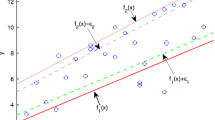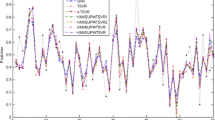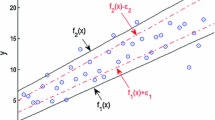Abstract
Twin support vector regression (TSVR) finds ϵ-insensitive up- and down-bound functions by resolving a pair of smaller-sized quadratic programming problems (QPPs) rather than a single large one as in a classical SVR, which makes its computational speed greatly improved. However the local information among samples are not exploited in TSVR. To make full use of the knowledge of samples and improve the prediction accuracy, a K-nearest neighbor-based weighted TSVR (KNNWTSVR) is proposed in this paper, where the local information among samples are utilized. Specifically, a major weight is given to the training sample if it has more K-nearest neighbors. Otherwise a minor weight is given to it. Moreover, to further enhance the computational speed, successive overrelaxation approach is employed to resolve the QPPs. Experimental results on eight benchmark datasets and a real dataset demonstrate our weighted TSVR not only yields lower prediction error but also costs lower running time in comparison with other algorithms.


Similar content being viewed by others
References
Cai D, He X, Zhang W, Han J (2007) Regularized locality preserving indexing via spectral regression. In: Proc 2007 ACM int. conf. on information and knowledge management
Cheng H, Tan P, Jin R (2010) Efficient algorithm for localized support vector machine. IEEE Trans Knowl Data Eng 22(4):537–549
Cover T, Hart P (1967) Nearest neighbor pattern classification. IEEE Trans Inf Theory 13:21–27
Diosan L, Rogozan A, Pecuchet J-P (2013) Improving classification performance of support vector machine by genetically optimising kernel shape and hyper-parameters. Appl Intell 36:280–294
Fung G, Mangasarian O (2001) Proximal support vector machine classifiers. In: Seven international proceedings on knowledge discovery and data mining, pp 77–86
Fung G, Mangasarian O (2005) Multicategory proximal support vector machine classifiers. Mach Learn 59:77–97
Ghorai S, Mukherjee A, Dutta P (2009) Nonparallel plane proximal classifier. Signal Process 89(4):510–522
Jayadeva, Khemchandani R, Chandra S (2007) Twin support vector machines for pattern classification. IEEE Trans Pattern Anal Mach Intell 29(5):905–910
Jayadeva, Khemchandani R, Chandra S (2007) Fuzzy multi-category proximal support vector classification via generalized eigenvalues. Soft Comput 11(7):679–685
Khemchandani R, Jayadeva, Chandra S (2009) Optimal kernel selection in twin support vector machines. Optim Lett 3(1):77–88
Kumar M, Gopal M (2009) Least squares twin support vector machines for pattern classification. Expert Syst Appl 36(4):7535–7543
Li I, Chen J, Wu J (2013) A fast prototype reduction method based on template reduction and visualization-induced self-organizing map for nearest neighbor algorithm. Appl Intell 39:564–582
Mangasarian O, Musicant D (1999) Successive overrelaxation for support vector machines. IEEE Trans Neural Netw 10:1032–1037
Matei O, Pop P, Vălean (2013) Optical character recognition in real environments using neural networks and k-nearest neighbor. Appl Intell 39:739–748
Owusu E, Zhan Y, Mao Q (2013) An SVM-AdaBoost facial expression recognition system. Appl Intell. doi:10.1007/s10489-013-0478-9
Peng X (2010) TSVR: an efficient twin support vector machine for regression. Neural Netw 23(3):365–372
Peng X (2010) A new twin support vector machine classifier and its geometric algorithms. Inf Sci 180(20):3863–3875
Ripley B (1996) Pattern recognition and neural networks. Cambridge University Press, Cambridge
Shao Y, Wang Z, Chen W, Deng N (2013) Least squares twin parametric-margin support vector machine for classification. Appl Intell 39:451–464
Vapnik V (1995) The nature of statistical learning theory. Springer, New York
Wang C, You W (2013) Boosting-SVM: effective learning with reduced data dimension. Appl Intell 39:465–474
Xu Y (2012) A rough margin-based linear ν support vector regression. Stat Probab Lett 82:528–534
Xu Y, Guo R (2014) An improved v-twin support vector machine. Applied Intell. doi:10.1007/s10489-013-0500-2
Xu Y, Wang L (2005) Fault diagnosis system based on rough set theory and support vector machine. Lect Notes Artif Intell 3614:981–988
Xu Y, Wang L (2012) A weighted twin support vector regression. Knowl-Based Syst 33:92–101
Xu Y, Wang L, Zhong P (2012) A rough margin-based ν-twin support vector machine. Neural Comput Appl 21:1307–1317
Xu Y, Lv X, Xi W (2012) A weighted multi-output support vector regression and its application. J Comput Inf Syst 8(9):3807–3814
Ye Q, Zhao C, Gao S, Zheng H (2012) Weighted twin support vector machines with local information and its application. Neural Netw 35:31–39
Acknowledgements
The authors gratefully acknowledge the helpful comments and suggestions of the reviewers, which have improved the presentation. This work was supported by the National Natural Science Foundation of China (No. 61153003, 11171346 and 11271367) and China Scholarship Fund (No. 201208110282).
Author information
Authors and Affiliations
Corresponding author
Rights and permissions
About this article
Cite this article
Xu, Y., Wang, L. K-nearest neighbor-based weighted twin support vector regression. Appl Intell 41, 299–309 (2014). https://doi.org/10.1007/s10489-014-0518-0
Published:
Issue Date:
DOI: https://doi.org/10.1007/s10489-014-0518-0




